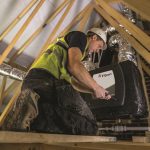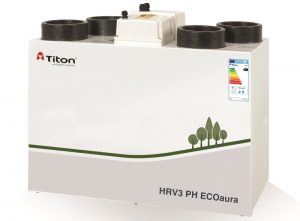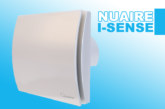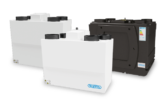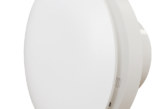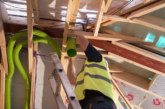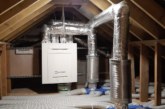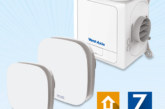Lee Caulfield, Sales Director, Titon Vent Systems Division, looks at the latest advances in ventilation products and explains how they can be utilised to improve air quality – and create a healthier indoor environment.
Ventilation, in addition to heating and insulation, has a key role to play in creating a healthy home. Indeed, when it comes to ensuring a good standard of indoor air quality (IAQ), ventilation can reduce condensation and associated mould growth, both of which have been linked to allergies, illnesses and health conditions such as asthma.
Air quality inside a home can be inadvertently affected by pollution from sources such as gas stoves, wood burners, home cleaning products and even personal care products like nail varnish and deodorant. With surveys showing that Europeans spend approximately 90% of their time indoors, it is clearly important to ensure the air inside a home remains as clean and healthy as possible.
“With people spending more time indoors, ventilation has a key role to play in ensuring the homes they live in remain healthy.”
While the health effects of outdoor or ambient air pollution have been well documented, less research has been undertaken on the impact of indoor air quality – although evidence that does exist suggests it can have a serious impact. Indeed, as part of the activity around the recent ‘Clean Air Day’, research attributed 9,000 of the estimated 40,000 deaths from air pollution each year in the UK to indoor air pollution.
There are many existing ventilation strategies for new-build properties in place, with mechanical ventilation with heat recovery (MVHR) being the best approach when looking at long-term energy-efficient requirements. This is the only option that can actually recover heat from exhaust air and, by specifying MVHR System 4 in a home, moisture and airborne contaminants can be removed, resulting in a healthier indoor environment for occupants.
As demand for new homes continues to rise, housebuilders are having to construct properties in a variety of different environments, ranging from brownfield sites to inner city areas, each with their own unique surroundings and complications. In some instances, extracting moisture and airborne contaminants via MVHR is not enough – and the actual air quality coming into a property also needs to be considered.
MVHR systems currently offer grades of filters that can be placed within the ventilation unit that combat PM10 and PM2.5 particulate matter, depending on the filter (F7 or G4). PM2.5 particulates measure less than 2.5 micrometres, making them too small to see with the eye, yet pose a significant health risk as they can easily find their way into people’s lungs and then the bloodstream. However, there are numerous other external contaminants posing a threat to IAQ. These include sulphur dioxide, hydrogen sulphide, hydrogen chloride, chlorine, ammonia odours, volatile organic compounds, solvents and nitrogen dioxide (NO2) – all of which are found in urban and highly polluted areas.
Fortunately, specially designed NO2 filters have now been introduced that can be added to an MVHR system and remove these pollutants, which are mainly produced by diesel engines. Any installed NO2 filters must conform to the EU Directive 2008/50/EC (a.k.a. the Clean Air for Europe programme or the CAFE Directive), which was introduced to protect against the negative effects of air pollution on human health and the environment. Such filters also need to comply with Part F (ventilation) of the Building Regulations, especially the pages relating to ADF’s performance criteria for dwellings, stating that exposure to nitrogen dioxide (NO2) should not exceed 288μg/m over a one-hour average, and 40μg/m over a long-term average.
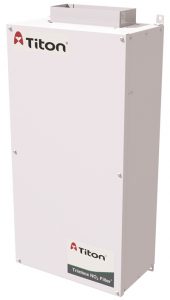
Compact filters
NO2 filters – such as Titon’s award-winning Trimbox – incorporate balanced flow technology to reduce NO2 to an acceptable mean concentration level of 40µg/m3. Indeed, independent tests have demonstrated such units to absorb 98% of NO2, not only in normal, continuous ventilation mode but also at boost or higher ventilation rates1.These filters can be installed in both inlet and supply ducting. Additionally, they can be used in small to large dwellings, provided they are able to operate with variable airflow.
Titon’s Trimbox is the most compact of these filters available on the market, offering the added benefit of a pre-filter option that provides increased protection from external contaminants. These units also boast exceptional acoustic properties, ensuring occupants are not disturbed by unwanted noise and helping to create a healthy home.
With people spending more time indoors, ventilation has a key role to play in ensuring the homes they live in remain healthy. Plus, with more properties now constructed in urban environments, it is more important than ever to utilise effective MVHR systems in conjunction with a suitable NO2 filter. This ensures pollutants – and predominantly exhaust gases from diesel engines – are effectively reduced. Utilising such ventilation products and systems will certainly help to create healthy homes, while simultaneously ensuring a high standard of indoor air quality.
- All performance data for the new filters has been derived by independent testing at a UKAS recognised test house. The testing regime was carried out to WHO and EU standards. The test report concludes that: “Both filter units performed very well, with nitrogen dioxide filtration performances of approximately 95% being achieved”.

